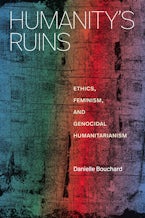In Humanity’s Ruins, Danielle Bouchard examines how genocidal aspirations animate contemporary Western humanitarian projects and discourses. Drawing on anticolonial and antiracist feminist critique, Bouchard argues that humanitarianism has functioned in the Cold War and post-Cold War eras to perpetuate longer-lived, fundamentally racist conceptualizations of humanity’s defining characteristics. She examines the aesthetics of humanitarian texts, which are filled with figures of the wounded, dead, and disappeared—the atomic bomb victim whose only remainder is a shadow imprinted on concrete, the grievously injured Muslim woman, the vanished members of Amazonian “uncontacted” tribes, the dying African - to elucidate how the appearance of these figures reaffirms a genocidal view of humanity that aligns with the continuation of Western imperial warfare. Humanitarian discourses conceive of humanity as a community which, by definition, is under existential threat from some humans who are explicitly or implicitly understood as needing to be eliminated. Bouchard invokes “humanity’s ruins” to expose the genocidal fantasy of a human world in which such threat has been eliminated in the interest of supposedly ensuring humanity’s survival.
Acknowledgments vii
Introduction. Cynicism, Death, and Humanitarianism: The Aesthetic of Ruination 1
1. Bomb Ethics: Vulnerable Humanity in the Anthropocene 41
2. Postcolonial Histories of the Bomb: Differential Temporalities of Destruction in Kidlat Tahimik’s Mababangong Baungugot and Soleymane Cissé’s Yeelen 77
3. Converting Absences into Signs: The War on Terror and the Humanitarian Necessity of Violence 111
4. Documentation as Eradication: The Amazon’s "Uncontacted Tribes" and the Securitizing of Humanity 149
5. A Differential Humanity: Beyond the New Feminist Ethics of Vulnerability 183
Coda. Zero Logics, Atomic Semiotics; or, an Aesthetics of Debris 218
Notes 227
Bibliography 263
Index 283

